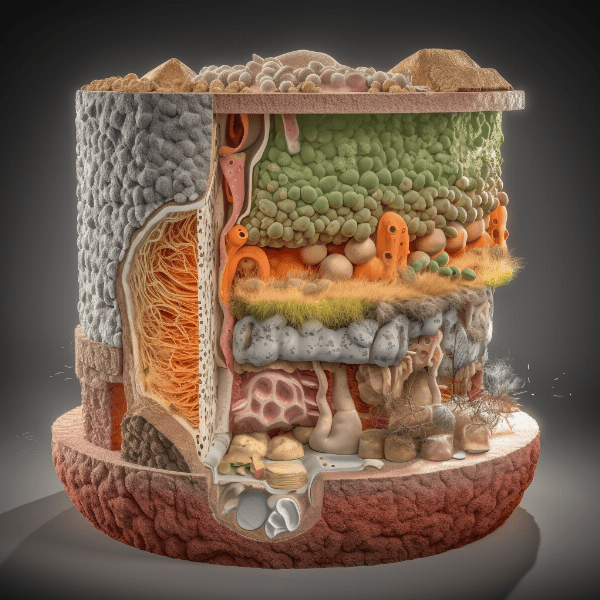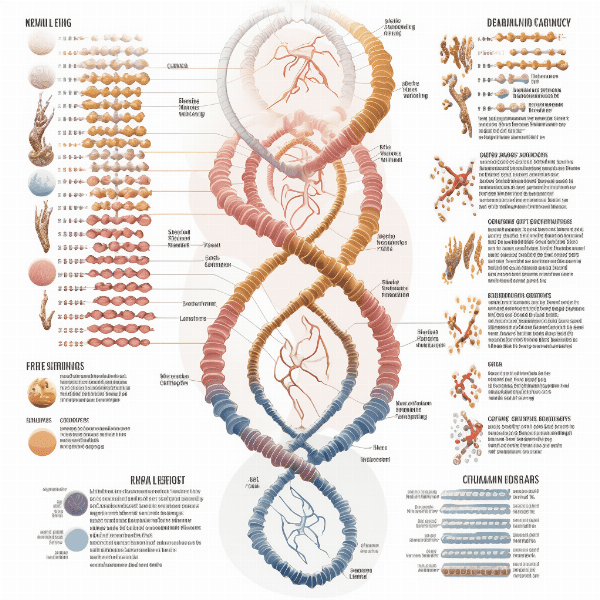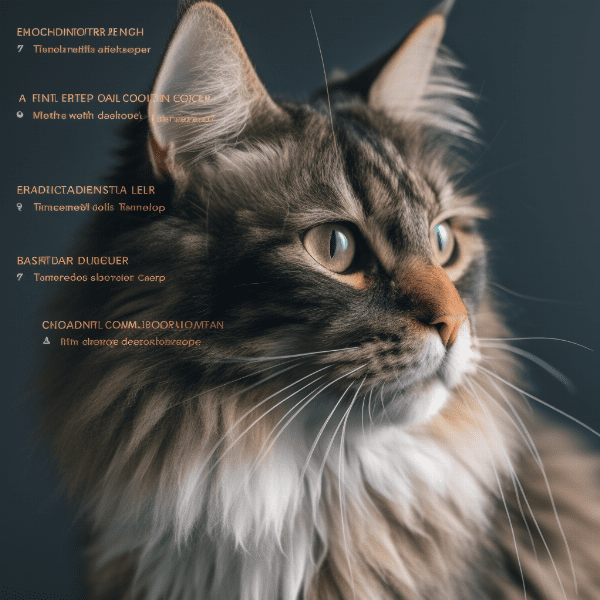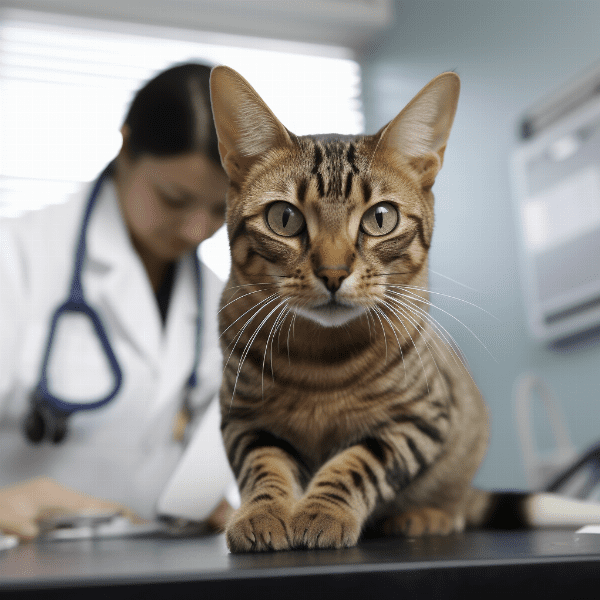Table of Contents
- What are Lysosomal Storage Diseases?
- Types of Lysosomal Storage Diseases in Cats
- Causes and Risk Factors of Lysosomal Storage Diseases in Cats
- Signs and Symptoms of Lysosomal Storage Diseases in Cats
- Diagnosis and Treatment of Lysosomal Storage Diseases in Cats
- Preventing Lysosomal Storage Diseases in Cats
- Managing Lysosomal Storage Diseases in Cats: Care and Support
- Future Directions in Lysosomal Storage Disease Research for Cats
- Living with a Cat with Lysosomal Storage Disease: Coping Strategies and Support
- Conclusion: Raising Awareness of Lysosomal Storage Diseases in Cats
What are Lysosomal Storage Diseases?
Lysosomal storage diseases (LSDs) are a group of rare genetic disorders that result from the accumulation of abnormal amounts of waste products inside the lysosomes, which are small sacs containing enzymes that break down and recycle materials in cells. When these enzymes are deficient or malfunctioning, the lysosomes become filled with undigested substances, leading to cellular dysfunction and damage.
Examples of Lysosomal Storage Diseases in Cats
- GM1 gangliosidosis
- Niemann-Pick disease
- Mucopolysaccharidosis
- Pompe disease
GM1 Gangliosidosis
Niemann-Pick Disease
Mucopolysaccharidosis
Pompe Disease
In the following sections, we will explore the causes, risk factors, signs and symptoms, diagnosis, treatment, and management strategies for LSDs in cats.

Types of Lysosomal Storage Diseases in Cats
There are several types of lysosomal storage diseases (LSDs) that can affect cats, each with its own unique set of signs and symptoms. In this section, we will discuss some of the most common types of LSDs seen in cats.
GM1 Gangliosidosis
As mentioned earlier, GM1 gangliosidosis is a rare inherited LSD that affects the nervous system of cats. It is caused by a deficiency in the enzyme beta-galactosidase, which leads to the accumulation of gangliosides in the brain and other tissues. This accumulation causes progressive neurological deterioration, weakness, and muscle wasting. GM1 gangliosidosis is typically fatal within the first year of life.
Niemann-Pick Disease
Niemann-Pick disease is a group of inherited LSDs that affect the metabolism of lipids, particularly sphingomyelin. In cats, Niemann-Pick disease is caused by a deficiency in the enzyme acid sphingomyelinase, which leads to the accumulation of sphingomyelin in various organs, including the liver, spleen, and nervous system. There are two types of Niemann-Pick disease seen in cats: type A and type B. Type A is the more severe form and is typically fatal within the first year of life, while type B is a milder form that can be managed with supportive care.
Mucopolysaccharidosis
Mucopolysaccharidosis (MPS) is a group of inherited LSDs that affect the breakdown of complex sugar molecules called glycosaminoglycans (GAGs). In cats, MPS is caused by a deficiency in one of several enzymes involved in GAG metabolism, which leads to the accumulation of GAGs in various tissues and organs. There are several different types of MPS seen in cats, including MPS I, MPS II, and MPS VI. Each type of MPS has its own set of signs and symptoms, but common symptoms include skeletal abnormalities, joint stiffness, respiratory problems, and corneal clouding.
Pompe Disease
Pompe disease is an inherited LSD that affects the metabolism of glycogen, a form of stored sugar in cells. In cats, Pompe disease is caused by a deficiency in the enzyme acid alpha-glucosidase, which leads to the accumulation of glycogen in various tissues, particularly muscle cells. This accumulation causes muscle weakness, exercise intolerance, and respiratory problems. Pompe disease is typically fatal within the first year of life.
Fabry Disease
Fabry disease is a rare inherited LSD that affects the metabolism of a lipid called globotriaosylceramide (GL-3). In cats, Fabry disease is caused by a deficiency in the enzyme alpha-galactosidase, which leads to the accumulation of GL-3 in various tissues and organs. This accumulation can cause a range of symptoms, including skin lesions, eye problems, kidney dysfunction, and neurological signs.

Causes and Risk Factors of Lysosomal Storage Diseases in Cats
Lysosomal storage diseases (LSDs) are caused by genetic mutations that affect the function of lysosomal enzymes and proteins. In cats, these mutations may be inherited in an autosomal recessive or X-linked pattern, meaning that the cat must inherit two copies of the mutated gene, one from each parent, to develop the disease. In some cases, LSDs can also occur sporadically due to de novo mutations that arise spontaneously in a cat’s DNA.
Autosomal Recessive Inheritance
Autosomal recessive inheritance is the most common mode of inheritance for LSDs in cats. This means that a cat must inherit two copies of the mutated gene, one from each parent, to develop the disease. If a cat inherits only one copy of the mutated gene, they are considered a carrier of the disease and will not show any signs of the disease. However, carriers can pass the mutated gene on to their offspring.
X-Linked Inheritance
X-linked inheritance is another mode of inheritance for LSDs in cats. This means that the mutated gene is located on the X chromosome, one of the two sex chromosomes. Since male cats have only one X chromosome, they are more likely to develop X-linked LSDs than female cats. Female cats can also develop X-linked LSDs, but they must inherit two copies of the mutated gene, one from each parent.
De Novo Mutations
In some cases, LSDs can occur sporadically due to de novo mutations that arise spontaneously in a cat’s DNA. These mutations are not inherited from either parent but occur randomly during the cat’s development. De novo mutations can occur in any gene, but they are more likely to occur in genes that are essential for development or that have a high mutation rate.
Breed Predisposition
Certain cat breeds may be more prone to developing LSDs due to a higher frequency of specific genetic mutations. For example, Siamese and related breeds are at increased risk for developing GM1 gangliosidosis, while Persian cats are at increased risk for developing MPS I. It is important for cat owners and breeders to be aware of breed-specific risks and to consider genetic testing before breeding.
In the following sections, we will explore the signs and symptoms of LSDs in cats, as well as how these diseases are diagnosed and treated.

Signs and Symptoms of Lysosomal Storage Diseases in Cats
Lysosomal storage diseases (LSDs) can cause a wide range of signs and symptoms in cats, depending on the type of LSD and the organs and tissues affected. Some LSDs may present with symptoms early in life, while others may not become apparent until later in life.
- Weakness
- Muscle wasting
- Difficulty walking or standing
- Seizures
- Blindness
- Head tremors
- Behavior changes
- Incoordination
- Loss of balance
- Rapid or labored breathing
- Exercise intolerance
- Respiratory distress
- Vomiting
- Diarrhea
- Poor appetite
- Weight loss
- Jaundice
- Skeletal abnormalities
- Joint stiffness
- Difficulty moving or walking
- Painful joints
Eye Symptoms
LSDs that affect the eyes, such as Fabry disease, can cause a range of eye symptoms in cats. These may include:
- Corneal clouding
- Vision loss
- Eye redness
- Eye discharge
It is important to note that not all cats with LSDs will exhibit all of these symptoms, and some cats may show no symptoms at all. If you suspect that your cat may have an LSD, it is important to consult with your veterinarian for an accurate diagnosis and appropriate treatment. In the following sections, we will explore how LSDs in cats are diagnosed and treated.

Diagnosis and Treatment of Lysosomal Storage Diseases in Cats
Diagnosing lysosomal storage diseases (LSDs) in cats can be challenging, as the signs and symptoms of these diseases can be similar to those of other conditions. However, early diagnosis and treatment are crucial for managing the disease and improving the cat’s quality of life.
Diagnosis of LSDs in Cats
Diagnosis of LSDs in cats typically involves a combination of medical history, physical examination, and laboratory testing. Your veterinarian may recommend the following tests:
- Blood tests to measure the levels of lysosomal enzymes and other markers of LSDs
- Urine tests to detect abnormal levels of GAGs
- Imaging tests such as X-rays or ultrasound to evaluate organ and tissue damage
- Genetic testing to identify the specific mutation causing the LSD
Treatment of LSDs in Cats
Currently, there is no cure for LSDs in cats. Treatment focuses on managing the symptoms of the disease and improving the cat’s quality of life. Treatment options may include:
- Symptomatic and supportive care such as fluid therapy, pain management, and nutritional support
- Enzyme replacement therapy, which involves administering a synthetic enzyme to replace the missing or deficient lysosomal enzyme
- Gene therapy, which involves delivering a functional copy of the mutated gene to the affected cells
- Bone marrow transplantation, which can replace the defective cells with healthy ones
The choice of treatment will depend on the specific LSD and the severity of the symptoms. Your veterinarian will work with you to develop a customized treatment plan that meets your cat’s individual needs.
Monitoring and Management of LSDs in Cats
LSDs in cats require ongoing monitoring and management to ensure the best possible outcome for the cat. Your veterinarian may recommend regular check-ups, laboratory testing, and imaging studies to monitor the cat’s condition and adjust the treatment plan as needed. It is also important to provide a supportive environment for the cat, with appropriate nutrition, exercise, and socialization.
In the following sections, we will explore ways to prevent LSDs in cats, as well as strategies for managing the disease and supporting cats with LSDs.

Preventing Lysosomal Storage Diseases in Cats
Preventing lysosomal storage diseases (LSDs) in cats involves identifying and managing the underlying genetic mutations that cause these diseases. While LSDs cannot always be prevented, there are steps that cat owners and breeders can take to reduce the risk of these diseases.
Genetic Testing and Breeding
Genetic testing is an important tool for identifying cats that are carriers of LSDs or at risk of developing these diseases. Breeders should consider genetic testing of their cats before breeding to avoid passing on genetic mutations to their offspring. Genetic testing can also help cat owners make informed decisions about breeding and choosing a cat for adoption.
Responsible Breeding Practices
Responsible breeding practices can help reduce the risk of LSDs in cats. Breeders should avoid breeding cats that are known carriers of genetic mutations for LSDs and should choose breeding pairs that are not closely related. Additionally, breeders should monitor their cats for signs of LSDs and seek veterinary care promptly if symptoms are observed.
Early Diagnosis and Treatment
Early diagnosis and treatment of LSDs in cats can help manage the disease and improve the cat’s quality of life. Cat owners should be aware of the signs and symptoms of LSDs and seek veterinary care promptly if their cat shows any of these symptoms. Regular check-ups and laboratory testing can also help detect LSDs early and facilitate prompt treatment.
Nutrition and Environmental Management
Proper nutrition and environmental management can also play a role in preventing LSDs in cats. A balanced diet and appropriate exercise can help keep cats healthy and reduce the risk of obesity and other health problems. Additionally, providing a clean and safe living environment can help reduce the risk of infections and other environmental stressors that can contribute to the development of LSDs.
In conclusion, preventing LSDs in cats requires a proactive approach that involves responsible breeding practices, genetic testing, early diagnosis and treatment, and proper nutrition and environmental management. By working together, cat owners, breeders, and veterinarians can help reduce the incidence of these rare but devastating diseases in cats.

Managing Lysosomal Storage Diseases in Cats: Care and Support
Managing lysosomal storage diseases (LSDs) in cats requires ongoing care and support to improve the cat’s quality of life and manage the symptoms of the disease. Here are some strategies for managing LSDs in cats:
Symptomatic and Supportive Care
Symptomatic and supportive care is an important component of managing LSDs in cats. This may include providing pain management, fluid therapy, and nutritional support to help maintain the cat’s overall health and well-being. Regular check-ups and monitoring can help detect changes in the cat’s condition and adjust the treatment plan as needed.
Bone Marrow Transplantation
Bone marrow transplantation is a treatment option for some types of LSDs in cats. This procedure involves replacing the cat’s defective bone marrow cells with healthy ones from a donor. Bone marrow transplantation can help correct the underlying genetic defect and reduce the symptoms of the disease. However, this procedure is expensive and carries significant risks and complications.
Supportive Environment
Providing a supportive environment for cats with LSDs is also important. This may include providing appropriate nutrition, exercise, and socialization to help keep the cat healthy and happy. Cats with LSDs may require special accommodations, such as ramps or litter boxes with low sides, to help them move and function more comfortably.
In conclusion, managing LSDs in cats requires a multi-disciplinary approach that involves a combination of symptomatic and supportive care, ERT, gene therapy, bone marrow transplantation, and a supportive environment. With the right care and support, cats with LSDs can lead fulfilling and happy lives.

Future Directions in Lysosomal Storage Disease Research for Cats
Lysosomal storage diseases (LSDs) in cats are rare but devastating diseases that can cause significant morbidity and mortality. While there have been advances in the diagnosis and treatment of LSDs in cats, there is still much to learn about these diseases. Here are some future directions in LSD research for cats:
Gene Therapy
Gene therapy is a promising area of research for LSDs in cats. This involves delivering a functional copy of the mutated gene to the affected cells, which can help correct the underlying genetic defect and reduce the symptoms of the disease. Researchers are working to develop new and more effective gene therapy techniques for LSDs in cats.
Enzyme Replacement Therapy
Enzyme replacement therapy (ERT) is a treatment option for some types of LSDs in cats. However, ERT is often limited by poor delivery to the affected tissues and the development of antibodies against the synthetic enzyme. Researchers are working to develop new and more effective ERT techniques, such as targeted enzyme replacement therapy, that can improve the delivery and efficacy of the synthetic enzyme.
Stem Cell Therapy
Stem cell therapy is another area of research for LSDs in cats. This involves using stem cells to replace the cat’s defective cells with healthy ones. Stem cells can differentiate into different types of cells, which can help restore the function of damaged tissues and organs. Researchers are working to develop new and more effective stem cell therapies for LSDs in cats.
Novel Therapies
Researchers are also exploring new and novel therapies for LSDs in cats, such as chaperone therapy, which involves using small molecules to stabilize the lysosomal enzyme and improve its function. Other therapies under investigation include gene editing, RNA-based therapies, and nanoparticles that can deliver therapeutic agents to the affected tissues.
In conclusion, LSD research for cats is an active area of investigation, with ongoing efforts to develop new and more effective treatments for these rare and devastating diseases. With continued research and collaboration, there is hope for a brighter future for cats with LSDs.

Living with a Cat with Lysosomal Storage Disease: Coping Strategies and Support
Caring for a cat with lysosomal storage disease (LSD) can be challenging, both emotionally and physically. Here are some coping strategies and support resources to help you and your cat through this difficult time:
Educate Yourself
Education is an important tool for coping with LSDs in cats. By learning about the disease, its symptoms, and available treatments, you can better understand and manage your cat’s condition. Your veterinarian can provide you with information and resources to help you learn more about your cat’s specific LSD.
Seek Support
Caring for a cat with an LSD can be emotionally taxing. Seeking support from friends, family, and support groups can help you cope with the stress and anxiety of caring for a sick pet. Your veterinarian may also be able to connect you with local support groups or online resources.
Practice Self-Care
Caring for a cat with an LSD can be physically demanding. Practicing self-care, such as getting enough rest, eating a healthy diet, and engaging in stress-reducing activities such as yoga or meditation, can help you manage the demands of caregiving.
Maintain a Routine
Maintaining a routine can help provide structure and stability for cats with LSDs. Regular feeding, exercise, and medication schedules can help keep your cat healthy and comfortable.
Stay Positive
Living with a cat with an LSD can be challenging, but it is important to stay positive and focus on the things you can control. Celebrate small victories, such as improved appetite or mobility, and stay hopeful for future advances in LSD research and treatment.
In conclusion, caring for a cat with an LSD can be challenging, but with education, support, self-care, routine, and a positive attitude, you can provide the best possible care for your cat and improve their quality of life.

Conclusion: Raising Awareness of Lysosomal Storage Diseases in Cats
Lysosomal storage diseases (LSDs) in cats are rare but devastating diseases that can cause significant morbidity and mortality. While there is no cure for LSDs in cats, there are treatments available that can help manage the disease and improve the cat’s quality of life.
Raising awareness of LSDs in cats is important to help identify and manage these diseases early. Cat owners, breeders, and veterinarians can work together to reduce the incidence of LSDs in cats and improve the lives of cats with these diseases.
By educating ourselves about LSDs, practicing responsible breeding, seeking veterinary care promptly, and supporting ongoing research and treatment development, we can make a difference in the lives of cats with LSDs.
We hope this guide has provided valuable information and resources for cat owners, breeders, and veterinarians on the diagnosis, treatment, and management of LSDs in cats. Let us continue to work together to raise awareness of these rare but important diseases and improve the lives of cats with LSDs.




